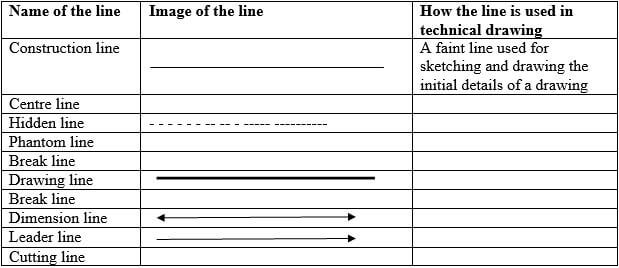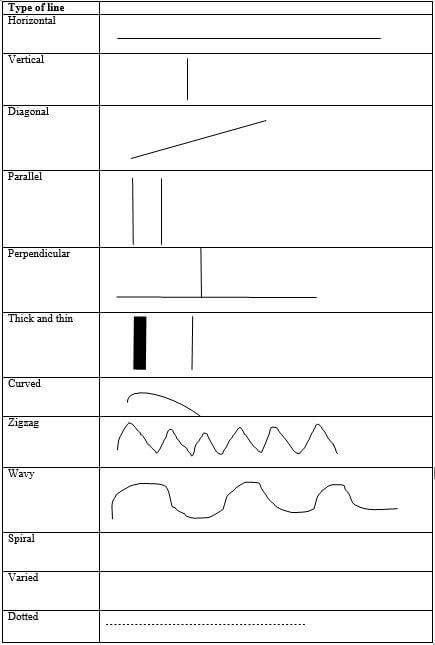What you get:
- Definition of a drawing
- Types of drawings
- Types of drawing used in technical fields
- Distinguishing artistic and technical drawings
- Uses of artistic and technical drawing in different fields
- Uses of artistic drawings
- Uses of technical drawing
- Applications of drawings in various careers
- Importance of drawing in day to day life
- Drawing instruments and equipments
- Drawing instruments and equipments used in technical drawing
- Uses of drawing instruments and equipments
- Drawing lines and shapes using drawing instruments
- Care and maintenance of drawing instruments and equipments
- Uses of drawing instruments and equipments in various careers
- Freehand sketching
- How to sketch lines freehand

DRAWINGS
TYPES OF DRAWINGS
Drawing are types of diagrams used for communication to show the shape and structure of a given idea or product.
Technical fields use drawings to draw designs of different items before they are made
Types of drawing used in technical fields
Drawing involves making marks on a surface to create images of forms and shapes.
- Artistic drawing – are made to visualize an idea and portray the general shape of an item, building or product.
They give a 3D view of an object. - Technical drawings – are made to give a precise and detailed view of an object.
They give information about how an object functions or how it is constructed.
Distinguishing artistic and technical drawings
Artistic and technical drawing can be distinguished using the characteristics like
- Purpose
Technical drawing provide accurate information about an object to allow easy manufacturing or repair
Artistic drawing are done to express one’s idea while beautifying the appearance of an object, a surface or a place - Presentation
Technical drawings are drawn on surface such as tracing paper, ammonia print or computer screens and are usually in standard sizes.
Artistic drawings can be drawn on paper, boards, walls canvas or fabric. These drawings do not have standard size - Interpretation
Technical drawing must be drawn to scale such that they are interpreted uniformly regardless of the geographical boundaries.
The interpretation of artistic drawings depends on the viewer - Level of precision
Technical drawing have to be drawn to scale for the accurate production and maintenance of the product
Artistic drawing show the general appearance of the product hence do not consider dimensions, shape or proportion
Uses of artistic and technical drawing in different fields
Uses of artistic drawings
- They are used to understand how the object or building will appear when in real life
- They help to keep records of historical events
- They are used to express imagination and creativity
- They represent feelings, actions and ideas
- They help us to develop observation and interpretative skills in order to understand the world
Uses of technical drawing
- They bridge communication between designers and producers
- They guide people in careers such as engineering when constructing and repairing different structures Eg. An engineer relies on technical drawings to make some parts of machines
- Technical drawing are used to represent objects whose dimensions follow set of international standards
Applications of drawings in various careers
People in careers that use both artistic and technical drawings include
- Architects
They use artistic drawings to show the outward appearance of the building and how the building will be intergraded with other items within its locality
They also use technical drawings to show the actual measurements and location of features such as windows and doors within the design - Construction workers
They use artistic drawings to create the finishing designs of the floor, roofs and walls.
They also use technical drawing to determine the location of doors, windows and other fixtures within the building - Electricians
They use technical drawing to identify the position of electrical ducts within a building wiring, installation or repair
They also use artistic drawings to determine the neatness and finish requires after installation or repair of electrical systems - Interior designers
They use artistic drawings when visualising the style, colour and other suitable to use
They also use technical drawings to determine the placement of different furnishing within a room or a building - Plumbers
They use artistic drawings to identify how to finish an area after installation of drainage pipes and other fixtures in the buildings
They use technical drawings to identify access points to areas having blockages or repairing repairs within the drainage points of a building - Product designers
They use artistic drawings to identify how different shapes, colours, images and writing will appear on a given object.
They use technical drawings to determine the size, material and shape of the product when viewed from different positions such as top, bottom and sides
Importance of drawing in day to day life
Some of the objects created from drawing are vehicles, roads, houses, furniture and electronics
Drawing helps us to learn to write and think creatively, develop hand to eye coordination and conceptualise ideas
Drawing instruments and equipments
Drawing can be done using a variety of instruments and equipments.
These instruments and equipments helps us to make neat and accurate drawings
Drawing instruments and equipments used in technical drawing
- Pencils
- Tee squares
- Drawing boards
- Drawing pens
- Rulers
- Sharpeners
- Drawing templates
- Erasers
- Pair of compass
Uses of drawing instruments and equipments
Drawing instrument or equipment | USE |
Pencils | Used to make initial sketches |
Erasers | Used to eliminate mistakes made while drawing |
Pens | Used to outline the final work |
Templates | Help to draw repeated letters, numbers and shapes accurately |
Drawing board | Used as a support surfaces to hold the paper when drawing |
Sharpeners | Used to make tips of pencils sharp |
Rulers | Used for measuring and marking accurate measurements |
Compasses |
Drawing lines and shapes using drawing instruments

Care and maintenance of drawing instruments and equipments
- Clean them well after use
- Avoid dropping the instruments or equipments. This prevents them from cracking and breaking
- Sharpen pencils when necessary. Do not press the pencil lead on a hard surface when sharpening
- Use each instrument or equipment for its intended purpose
Eg measuring tools should be used for measuring - Always store the instruments and equipments safely when they are not in use
NB
Drawing instruments and equipments are cared for and maintained well in order for them to work well and make neat and accurate drawings.
Uses of drawing instruments and equipments in various careers
- Architects
Use different drawing instruments to design good buildings - Interior designers
Use drawing instruments and skills to help people plan and decorate the spaces they live in - Fashion designers
Use drawing instruments to come up with creative ideas on how different outfits should be made.
Most of the clothes we wear were design by somebody
Fashion designers work closely with tailors - Tailors
Use drawing instruments to draw designs of clothes before they are made - Illustrators
Draw pictures both in hard copies and in digital form
Most of the pictures in textbooks were drawn by illustrators - Carpenters
Draw furniture before making them
Freehand sketching
Free hand sketching is drawing without the use of measuring instruments
How to sketch lines freehand
Different types of lines are used in freehand sketching
The measurement, direction and thickness of the lines can be varied to enhance the mood and character portrayed in the drawings

How to sketch two dimensional shapes using freehand
Download Drawings - Grade 7 Pre-Technical Studies Revision Notes.
Tap Here to Download for 30/-
Get on WhatsApp for 30/-
Why download?
- ✔ To read offline at any time.
- ✔ To Print at your convenience
- ✔ Share Easily with Friends / Students
